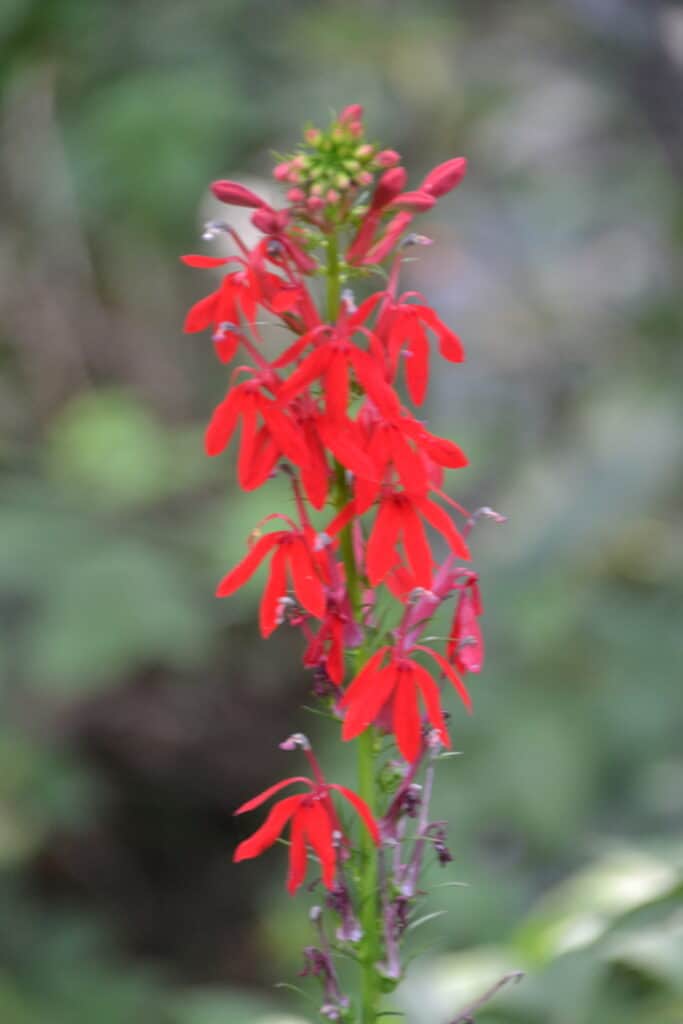Here’s what’s blooming in town this week to make your walks more enjoyable
By Laura Eisener
Vegetables that like hot weather are starting to produce a bigger harvest. Among the most popular are tomatoes, which come in a wide range of sizes and styles. While we think of ripe tomatoes as being red, some varieties may be yellow, orange or even blackish purple when ripe. Large tomatoes are popular for slicing, while smaller tomatoes are often in demand for salads and other uses. They also come in other shapes than round, often named for the fruits whose shapes they may resemble. Cherry tomatoes are small round tomatoes. Pear tomatoes are small heirloom variety tomatoes that are shaped like pears, and there are yellow, red and orange pear varieties. Grape tomatoes are oval shaped, and there are strawberry tomatoes that are broad at their stem end and somewhat more pointed at the tip, like a strawberry. The community garden at St. John’s has a wide range of tomatoes ripening, and many home gardeners also are getting a good tomato crop now, whether planted in the ground or in pots.
Both cardinal flowers (Lobelia cardinalis) and the bird known as northern cardinal (Cardinalis cardinalis) get their names from the red garments originally worn by some members of the Catholic clergy. The vivid color attracts attention, and both flower and bird may be attracting attention in the garden now. The cardinal flower is a perennial that likes shady woods, or damp sites in either sun or shade. It is widespread throughout much of North America and is seen in all parts of New England. The individual flowers, which look somewhat like a red bird in flight, grow on spikes, with lower flowers opening first and upper ones opening a week or more later than the lowest ones, so each plant may produce blossoms over a period of several weeks in late summer.
One of the most popular shrubs in bloom now is the versatile rose of Sharon or althea (Hibiscus syriacus), which thrives and blooms in full sun or part shade. Despite its common name, it is not related to roses. There are several different hibiscus species we may be growing in our gardens. The tropical Hawaiian or Chinese hibiscus (Hibiscus rosa-sinensis) is a woody plant with a wide range of flower colors, including yellow, red, orange, pink, purple and white. They would not survive a New England winter but can be treated as an annual up to the first frost or overwintered in a greenhouse or indoors near a window. Rose of Sharon is completely hardy in most of New England, but the flowers come in a somewhat more limited palette – pink, light purple or white, occasionally with a splash of red near the flower’s center.
The dinner plate-sized flowers of rose mallow (Hibiscus moscheutos) that can be seen around town now are a species of perennial hibiscus that is native to North America. While it grows wild in the southeast, it is hardy in much of New England, and its tropical looking flowers stand out in our gardens in late summer. Flowers may be pink, red, white or a combination of these colors. While leaves are often green, some varieties have dark red foliage. Like the flowers, the leaves are larger than most of the foliage in our gardens, giving a bold textured tropical appearance.
If we look up at the sky this week, we will see the full moon on August 19. It is often called the sturgeon moon, since Algonquin tribes noted that the sturgeon fish was especially abundant in late summer. It is also sometimes called the corn moon, although sometimes this term is applied to the September full moon, especially if it occurs early in the month. This month’s full moon is the first of four supermoons in a row this year, which means that the next four full moons including the one this month appear slightly larger than usual.
Editor’s Note: Laura Eisener is a landscape design consultant who helps homeowners with landscape design, plant selection and placement of trees and shrubs, as well as perennials. She is a member of the Saugus Garden Club and offered to write a series of articles about “what’s blooming in town” shortly after the outbreak of the COVID-19 pandemic. She was inspired after seeing so many people taking up walking.


